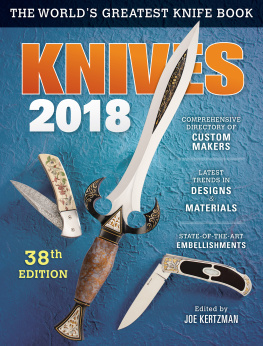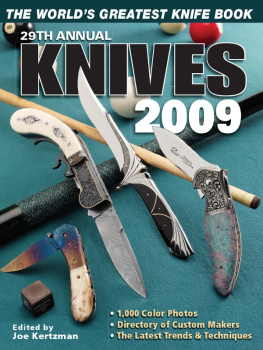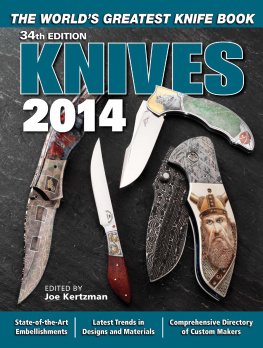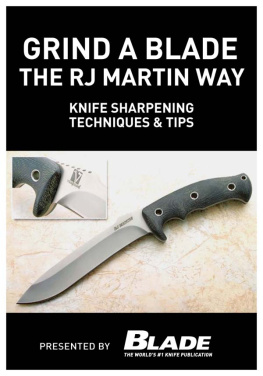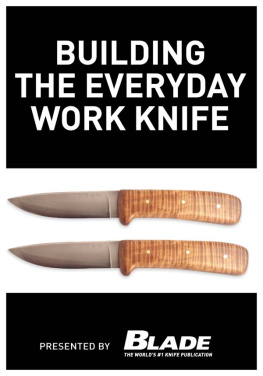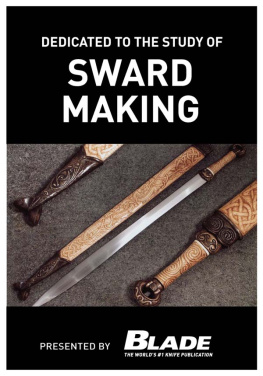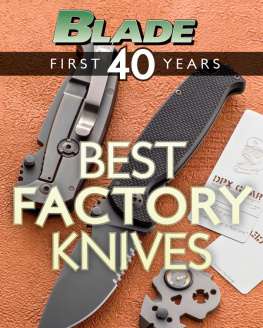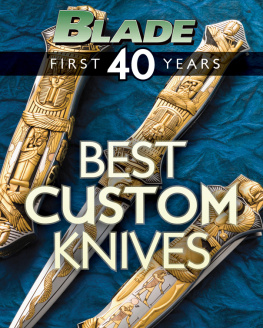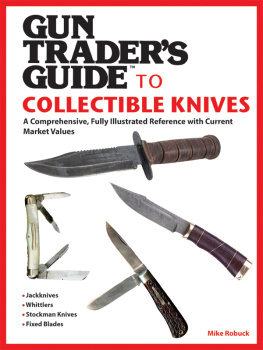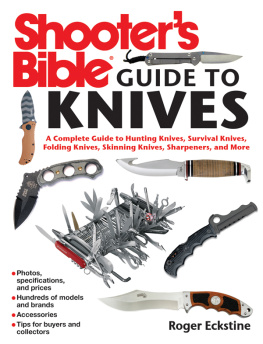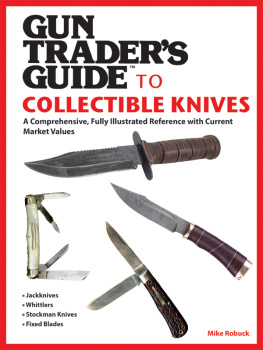Dedication and Acknowledgments
L ooking at the knives in this book, collectors and enthusiasts everywhere are reminded of something that they and hunters, outdoorsmen and outdoorswomen, sportsmen and sportswomen, farmers, linesmen, utility workers, ranchers, cabinet makers, construction workers and millions of other people have pondered for centuries. How could anyone, no matter their political slant, motivation or agenda, want to outlaw knives of any kind, shape or form? Thumbing through the pages of Knives 2013, it seems absurd to even consider banning such handcrafted works of art. Its implausible that a single piece be considered a dangerous weapon in the hands of anyone but the most deranged of human beings.
Yet, there are people, as witnessed for decades, who want to make it illegal to own and carry anything from daggers to switchblades, from swords to one-hand-opening spring-assisted flipper folders. In the name of concerned citizenry and self-righteous politicians, they lobby to outlaw edged tools, to permanently ink their demise through laws, on dockets and by manipulation of the court system. There are those who want to forever ban knives from public ownership and carry.
It is for these reasons and more that I not only acknowledge Knife Rights and the American Knife & Tool Institute (AKTI), but also dedicate this book to these two organizations that actively protect the rights of knife-carrying citizens in this country and across the globe. The American Knife & Tool Institute (www.akti.org) is a nonprofit association that has been a voice of advocacy for the entire knife community since 1998, ensuring that Americans will always be able to make, buy, sell, own, carry and use knives and edged tools. The AKTI is recognized worldwide and respected as a credible, accurate source of knife legislation information, legislative input and industry information. The organization has a successful, proven record of accomplishments in making effective changes to restrictive knife laws and promoting reasonable and responsible laws and enforcement.
Knife Rights (www.kniferights.org) provides knife and edged-tool owners an effective voice to influence public policy and to oppose efforts to restrict the right to own, use and carry knives and edged tools. It encourages safe, responsible and lawful use of knives through education and outreach, enhancing positive perceptions of knives and edged tools and their owners and users. It encourages the marketing of knives in a responsible manner conducive to the organizations goals, and it cooperates with advocacy organizations that have complementary interests and goals.
It is with pleasure that I recognize the work of Doug Ritter of Knife Rights and Jan Billeb of the American Knife & Tool Institute, as well as all their members, board members, presidents, vice-presidents, contributors and supporters.
Additionally, Id of course be remiss if I didnt dedicate this book to the F&W Media staff that helps make the Knives annual a reality each yearJim Schlender, Corrina Peterson, Steve Shackleford, Sharon Bartsch, Lori Hallman and Bruce Wolberg. And finally to my wife, Tricia, our kids, Danny and Cora, and my parents Jack and Cathy, all of whom have helped shape me into the editor and man that I am today. Thank you to each and every one of you.
Joe Kertzman
On The Cover
T heres something for everyone to like on the front cover of Knives 2013, starting with a Nathan Carothers fully integral dagger (far left) machined from a single piece of CPM-154 steel, heat treated by Paul Bos, then given four handle scales of resin-impregnated maple burl made by Simply Nicholas. The pins are hidden, the steel hand finished with stones before polishing, and the maple burl a dark green. Standing to its right is Seeing Scarlet, a Ron Appleton creation including a 440C blade with spherical contours, a red-anodized 6061-T6-aluminum handle and a titanium InfiLock mechanism with soft close modification in a fashion only Appleton could accomplish. Looming large to its right is an impressive Steven Rapp knife, his interpretation of a circa-1800-1850 Sheffield Wostenholm IXL piecea bowie, but Rapps is a daggershown at the Crystal Palace Exhibition, which eventually became the Worlds Fair. Rapps version includes a 13.5-inch, double-ground 440C blade, a cast guard and pommel by Mark DeGraffenried, and an ancient-ivory handle. So engraved and gorgeous we had to look at it lying down (the knife, not us) is an Emmanuel Esposito Rhino tab-lock folder showcasing Brian Hochstrats incredible Italian bulino-style engraving and gold-appliqu depicting scenes from Homers poems the Iliad (one side of the handle) and the Odyssey. It also sports an RWL-34 blade and 416 stainless steel frame. If that doesnt satisfy the knife lover in you, nothing will.

Introduction
H onestly, knifemakers are helping to revive the U.S. economy. Its a theory Ive heard and read about, one thats been bandied around lately in newspapers, on television news and within online forums and articles. Knifemakers are not specifically mentioned or pinpointed, but they might as well be. The thought process goes like this: after the bank bailouts, housing collapse and stock market crash (or at the least the great recession), the unemployment rate skyrocketed and people found themselves out of work, forced from their homes, in debt, bankrupt or suffering extreme poverty. Large corporations like General Motors, Lehman Brothers and Delta Airlines were also bankrupt, and no one was hiring. There wasnt a quick fix for reviving the economy, and the only thing, theorized some, that would at least help jump-start a recovery would be innovation, self startersentrepreneurs opening their own small businesses.
Enter the innovative knifemaker.
Starting a business is never easy, but the American spirit is not about taking the easy way out, and knifemakers have been going it alone for as long as hammers have been hitting anvils. Few of those hammerheads strike gold, but there is pride in workmanship, in being a craftsman. The quality of workmanship that modern custom knifemakers exhibit is unsurpassed, and the innovation in custom knives has never been more widespread. People unfamiliar with the state of custom knifemaking find themselves flabbergasted by the knives made today, blown away by the quality, craftsmanship and artistry. Those who are familiar still find themselves in awe at the beauty of the knives and ability of the knifemakers.
To say that knifemakers have a hand in reviving the U.S. economy is not such a stretch after all, and to go further and say theyre working on the world economy is not so farfetched. Knifemakers listed in the Custom Knifemaker Directory of Knives 2013 represent 30 countries around the world. Innovations in knives often coincide with those in the steel industry. Yet theres more to a knife than a blade, and thus advancements in materials, mechanisms and patterns further propel custom knives into the technology sector here and abroad.


